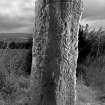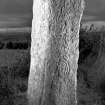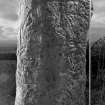Keillor
Pictish Symbol Stone (Pictish)
Site Name Keillor
Classification Pictish Symbol Stone (Pictish)
Alternative Name(s) Baldowrie Farm; Baldowrie Symbol Stone; High Keillor
Canmore ID 30545
Site Number NO23NE 3.02
NGR NO 27331 39760
Datum OSGB36 - NGR
Permalink http://canmore.org.uk/site/30545
- Council Perth And Kinross
- Parish Kettins
- Former Region Tayside
- Former District Perth And Kinross
- Former County Angus
Keillor, Perthshire, Pictish symbol stone
Measurements: H 1.98m, W 0.83m
Stone type: granite
Place of discovery: NO 2733 3976
Present location: in situ on the north slope of Keillor Hill.
Evidence for discovery: recorded by Skene in 1832 standing on a mound. By the late 1840s the upper part had fallen (Chalmers 1848), and it was re-erected sometime between 1848 and 1856 clamped together in a stone base (Stuart 1856).
Present condition: very worn.
Description
This pillar-like stone bears three symbols: a wolf at the top above a double disc and Z-rod, and a mirror below.
Date: seventh century.
References: Skene 1832, 21; Chalmers 1848, pl 20; Stuart 1856, 34; Fraser 2008, no 186.
Compiled by A Ritchie 2016
NO23NE 3.02 27331 39760.
(NO 2732 3975) Sculptured Stone (NR)
OS 6" map (1959)
This Class I symbol stone stands on an enclosed knoll or tumulus, in which several cists containing urns have been found. The stone, 6'4" high by 2'9" in width, is incised with symbols as illustrated.
It is fixed in a modern base with iron clamps.
J R Allen and J Anderson 1903; A J Warden 1880; 1884
Field Visit (11 July 1943)
This site was recorded as part of the RCAHMS Emergency Survey, undertaken by Angus Graham and Vere Gordon Childe during World War 2. The project archive has been catalogued during 2013-2014 and the material, which includes notebooks, manuscripts, typescripts, plans and photographs, is now available online.
Information from RCAHMS (GF Geddes) 2 December 2014.
Field Visit (28 April 1958)
This symbol stone is as described. The turf-covered barrow on which it stands has been c.10.0m in diameter, but its SE side has been cut away by the road. Its height is 1.3m above the road level outside the retaining enclosure wall.
Surveyed at 1:2500.
Visited by OS (JLD) 28 April 1958 and (RD) 7 October 1970
Field Visit (7 October 1970)
This symbol stone is as described.
Visited by OS (RD) 7 October 1970.
External Reference (1980)
Four miles E of Coupar Angus is a small tumulus on which stands a stone of grey gneiss, 1.9m x 0.83m. It is fixed into a modern base with iron clamps. Roughly rectangular in shape, it bears, at the top, a partly defaced beast resembling a wolf, the double-disc and Z-rod symbol and the remains of a mirror at the bottom.
Information from R Jones 1980.
Field Visit (4 April 1989)
This granite slab, which measures 1.98m in length and 1.75m in girth at the present ground level, is set upright in a modern socket-stone on the summit of the cairn NO23NE 3.01. Aligned ENE-WSW, the stone has incised on it an animal, possibly a wolf, at the top, a double-disc and Z-rod at the centre, and part of what may have been a pecked double circle at the bottom. When Chalmers recorded it in 1848, the lower portion remained upright, while the top part lay on the ground nearby; the prominent crack at the base of the stone can be identified on Chalmers' drawing. Stuart (1856) records the circumstances of the re-erection of the stone; it was inserted in a base and secured by iron clamps. It is likely that at this tme the ground was mounded up around the stone to provide further support.
Visited by RCAHMS (JRS) 4 April 1989.
P Chalmers 1848; J Stuart 1856; R Jones 1980; A Jackson 1984.
Reference (1997)
Class I symbol stone with on the south-east face a wolf,a double-disc and Z-rod and a mirror and comb arranged vertically.
A Mack 1997




























































